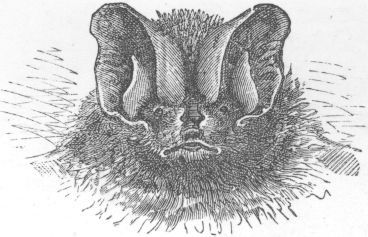| Page 27 | |
|
Natural History of the Mammalia of India and Ceylon - by Robert A. Sterndale F.R.G.S., F.Z.S. (1884)
| |
| prev page next page | contents |
GENUS MINIOPTERUS (Bonaparte)
DESCRIPTION.—Crown of head abruptly and very considerably raised above the face line; ears separate, rhomboidal, the outer margin carried forward to the angle of the mouth; tragus like that in Vesperugo; first phalanx of the second or longest finger very short; feet long and slender; tail as long as head and body, wholly contained in the membrane.
Dentition: Inc., 2—2/6; can., 1—1/1—1, premolars, 2—2/3—3, molars, 3—3/3—3.
119. MINIOPTERUS SCHREIBERSII.
HABITAT.—Burmah and Ceylon.
DESCRIPTION.—Colour of fur varies, the basal half of the hair always dark greyish black, dark brown or black; the extremities varying from light grey to light reddish-grey, dark reddish-brown and black. For further details see Dobson's monograph.
GENUS BARBASTELLUS

Synotus barbastellus
Ears large, connate at the base in front, triangular, emarginate on the outer margin, broad, concealing the back of the head, hairy in the middle; tragus broad at the base, narrow at the tip, and curved outwardly.
Dentition: Inc., 2—2/6; can., 1—1/1—1; premolars, 2—2/2—2; molars, 3—3/3—3.
120. BARBASTELLUS COMMUNIS.
(Jerdon's No. 65.)
HABITAT.—Himalayas, Nepal and Mussoorie.
DESCRIPTION.—Fur above blackish brown; the hairs fulvous at the tips; abdomen greyish brown; hairs fine silky.
SIZE.—Head and body, 2 inches; tail, 1-2/12; expanse; 10½.—Jerdon.
This is the same as the English Barbastelle, and it appears in Dobson's monograph as Synotus Darjeelinensis.
121. NYCTOPHILUS GEOFFROYI.
(Jerdon's No. 66.)
HABITAT.—Mussoorie.
Jerdon here goes back to the nose-leafed bats. I can find no trace of it in Dobson's monograph, which is so exhaustive as far as Asiatic species are concerned.
DESCRIPTION.—Over the eyes, at the hind corner, a tuft of black hair; fur dark brown, above throat and flank brownish-white; below black with white tips. A simple transverse nose-leaf; ears large, ovoid, united at base as in Plecotus.
SIZE.—Head and body, 1¾ to 2 inches; tail, 1-5/12; expanse, 9¾.
We have now concluded our notice of Indian bats but yet much is to be discovered
concerning them. Very little is known of the habits of these small nocturnal
animals, only a few of the most familiar large ones are such as one can
discourse upon in a popular way; the lives and habits of the rest are a blank to
us. We see them flit about rapidly in the dusky evening, and capture one here
and there, but, after a bare description, in most cases very uninteresting to
all save those who are "bat fanciers," what can be said about them? Many of them
have been written about for a century, yet how little knowledge has been gained!
It has been no small labour to collate all the foregoing species, and to compare
them with various works; it would have been a most difficult task but for the
assistance I have received from Dr. Dobson's book, which every naturalist should possess if he desires to have a thorough record of all the Indian Chiroptera.
